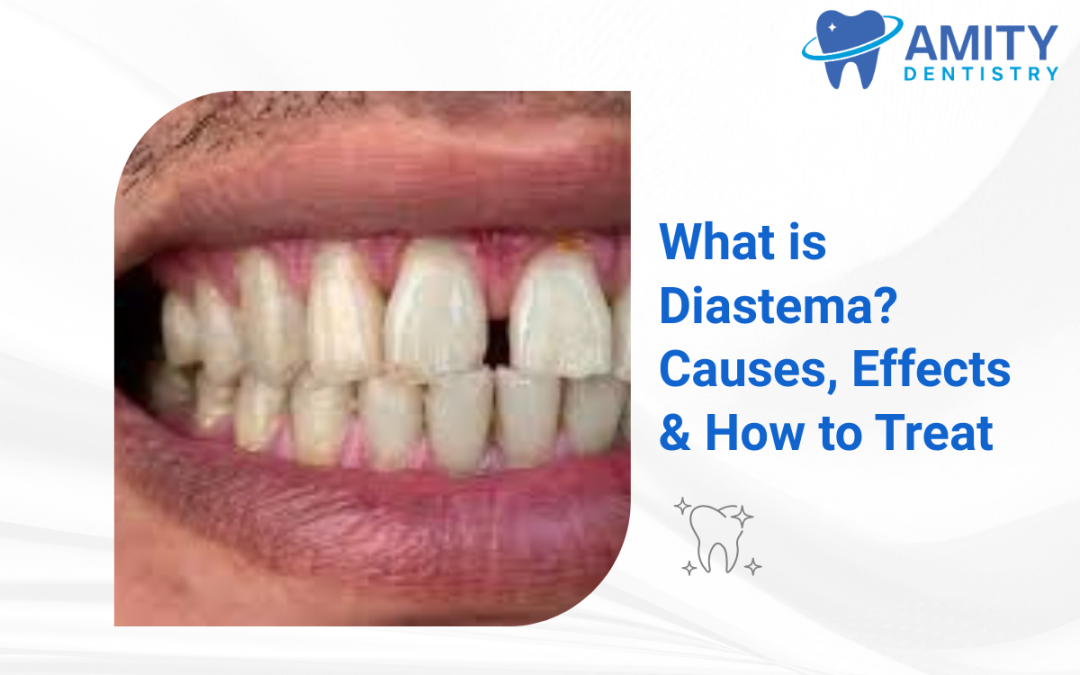One of the first things people notice about you is your wonderful smile when talking to someone new or an old friend.
Every smile is different, but the feature that may heavily stand out is a noticeable gap between your two front teeth, also known as diastema.
Many people love having this gap in their teeth as it compliments their personality very well. But what exactly is a diastema, why does it happen, and how can modern dentistry help?
At Amity Dentistry in Pineville, we see patients every week who are curious about closing gaps in their teeth or simply want to understand whether treatment is necessary.
This article will give you super helpful insights into what a diastema is, its causes, its potential effects, and the full range of treatment options available today.
What Exactly is Diastema?
The term diastema comes from the Greek word meaning “interval” or “space.” In dentistry, it refers to a gap or space between two teeth. Most often, it occurs between the upper front teeth (the central incisors), but it can appear anywhere in the mouth.
Some diastemas are so small they go unnoticed. Others are wide enough to draw attention when a person smiles or speaks. The size and location of the gap, as well as the main cause, determine whether treatment is necessary.
What’s important to remember is that a diastema is not inherently “bad.” For example, in some cultures, a gap between the teeth is considered a sign of beauty, luck, or fertility. In other cases, it may be associated with oral health issues that need professional care.
Prevalence of Diastema
Diastemas are very common among children. When the baby teeth fall out and the permanent adult teeth start to grow, diastema usually goes away there.
However, studies suggest that anywhere between 5% and 20% of adults have some form of diastema. It may be completely harmless but may also be an indicator of an underlying dental issue.
On the bright side, many parts of Africa and France consider diastema as a good luck charm, indicating beauty, good luck and prosperity.
It is often referred to as the “lucky tooth”. But most people in the west get rid of it mostly to work on their aesthetics.
What are the Common Causes of Diastema?
Not all diastemas are created equal. The space can form due to developmental, genetic, or lifestyle-related factors. Here are some common causes of diastema often observed in people:
1. Natural Growth and Development
Children often experience gaps between teeth as part of normal growth. When baby teeth fall out, spaces may appear before permanent teeth come in. In most cases, these spaces close as adult teeth erupt, but sometimes they persist.
2. Genetic Factors
Genetics play a major role in tooth and jaw development. If you inherit a larger jaw size or smaller teeth, there may not be enough tooth material to fill the available space, creating gaps. Family history often predicts whether someone will develop a diastema.
3. Mismatch Between Tooth Size and Jaw Size
If the teeth are proportionally too small for the jaw, extra space remains. Conversely, if the jaw is especially wide, even normally sized teeth may not meet properly.
4. Oversized or Low Labial Frenum
The labial frenum is the band of tissue connecting the inside of the upper lip to the gum just above the two front teeth. In some people, this frenum is thick or extends too far down, pushing the teeth apart and preventing them from closing naturally.
5. Oral Habits in Childhood
Children have a pesky habit of sucking their thumb. This may cause the teeth to move forward, making diastema more permanent or prevalent.
Habitually pushing the tongue against the teeth when swallowing or speaking can also force teeth apart over time.
6. Gum Disease (Periodontitis)
When gum disease advances, it damages the bone that supports the teeth. As bone density decreases, teeth may shift, creating new gaps where none previously existed.
7. Tooth Loss or Missing Teeth
If teeth are missing or extracted without replacement, the neighboring teeth may drift, leaving visible spaces.
8. Incorrect Bite (Malocclusion)
Misaligned jaws or improper bite patterns can create uneven spacing and cause diastemas.
What are the Effects of a Diastema?
While some people experience no issues, a diastema can have cosmetic, functional, and even health-related impacts.
Some of these effects include;
1. Cosmetic Concerns
For many patients, the primary concern is appearance. A gap may affect confidence in social or professional settings.
2. Speech Issues
Large diastemas, especially between the front teeth, may affect speech, causing lisps or difficulty pronouncing certain words.
3. Oral Hygiene
Food particles may get trapped in wide gaps, increasing the risk of plaque buildup, gum irritation, and cavities if not properly cleaned.
4. Bite Problems
If the gap is caused by bite misalignment, it can lead to uneven wear on teeth, jaw discomfort, or difficulty chewing.
5. Psychological Impact
Studies have shown that dental appearance can significantly affect self-esteem. For patients who feel self-conscious about their gap, treatment often brings both aesthetic and emotional relief.
Do All Diastemas Require Treatment?
The short answer is: no.
If the gap is small, does not interfere with bite or speech, and is not linked to gum disease or missing teeth, treatment may not be necessary.
Some people embrace their diastema as a unique feature that sets their smile apart.
However, if the diastema is wide, increasing in size, or associated with oral health problems, professional evaluation and treatment are recommended.
Treatment Options for Diastema
Modern dentistry offers multiple solutions, ranging from simple cosmetic fixes to more comprehensive orthodontic care. The right choice depends on the cause, the size of the gap, and your personal goals.
1. Orthodontic Treatment (Braces or Clear Aligners)
Orthodontics gradually shifts teeth into proper alignment. Then, traditional braces, ceramic braces, or clear aligners (such as Invisalign®) are fitted in the mouth. This fixes larger gaps, multiple gaps, or gaps caused by bite misalignment.
The whole process typically takes 6–24 months depending on severity.
Permanent correction, improves overall alignment.
Longer treatment time, higher cost.
2. Dental Bonding
- How it works: A tooth-colored resin is applied and shaped to fill the space.
- Best for: Small to moderate gaps.
- Timeframe: One visit, usually less than an hour.
- Pros: Quick, affordable, painless.
- Cons: Less durable than veneers; may chip or stain over time.
3. Porcelain Veneers
- How it works: Thin shells of porcelain are custom-made to cover the front of teeth.
- Best for: Moderate gaps, especially when combined with shape or color corrections.
- Timeframe: Usually 2–3 visits.
- Pros: Long-lasting, highly aesthetic, stain-resistant.
- Cons: More expensive, requires slight enamel removal.
4. Dental Crowns
- How it works: A crown covers the entire tooth, improving both function and appearance.
- Best for: Teeth that are small, misshapen, or weakened.
- Pros: Strong and durable.
- Cons: More invasive, higher cost.
5. Frenectomy
- How it works: If a thick labial frenum is the cause, a small surgical procedure removes or repositions the tissue.
- Best for: Frenum-related diastemas, usually combined with orthodontics.
- Pros: Prevents gap from reopening after orthodontic treatment.
- Cons: Minor surgery, may require healing time.
6. Periodontal Treatment
- How it works: Treat gum disease first with scaling, root planing, or surgery before addressing the gap.
- Best for: Gaps caused by bone or gum loss.
- Pros: Protects long-term oral health.
- Cons: Multiple appointments may be needed.
Comparing Treatment Options
| Treatment | Best For | Timeframe | Durability |
| Orthodontics | Large/multiple gaps, bite issues | 6–24 months | Permanent (with retention) |
| Bonding | Small gaps | 1 visit | 3–7 years |
| Veneers | Moderate gaps, cosmetic upgrades | 2–3 visits | 10–15 years |
| Crowns | Functional + cosmetic | 2–3 visits | 10–15 years |
| Frenectomy | Tissue-related gaps | 1 visit | Permanent |
| Periodontal care | Gum disease gaps | Varies | Depends on disease |
Final Thoughts
A diastema may be as simple as a cosmetic feature or it may be a sign of underlying dental or gum issues.
At Amity Dentistry, we believe your smile should reflect your confidence. If you’re considering gap teeth treatment in Pineville, our team is here to guide you through every option, from orthodontics to cosmetic dentistry.
Why Choose Amity Dentistry in Pineville?
At Amity Dentistry, we understand that every patient’s smile is unique. Whether your diastema is a cosmetic concern, a functional issue, or simply a feature you’re curious about, we provide personalized evaluations and treatment plans.
- Comprehensive Orthodontic Care – From traditional braces to clear aligners.
- Cosmetic Dentistry Options – Including bonding, veneers, and crowns.
- Periodontal Expertise – For gaps caused by gum disease.
- Comfort & Convenience – State-of-the-art technology and a patient-first approach.
Contact Amity Dentistry in Pineville today to schedule your consultation and learn how we can help you achieve the smile you’ve always wanted.

